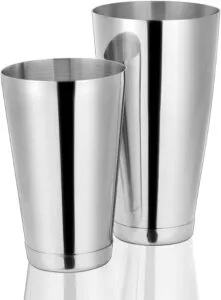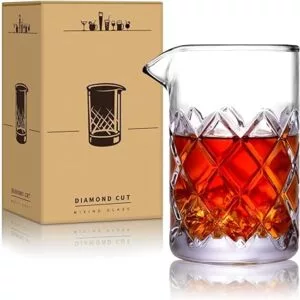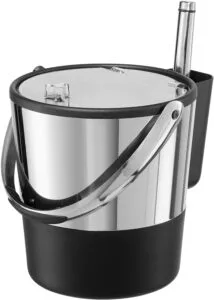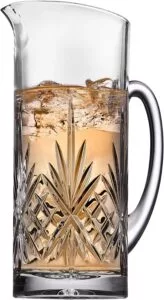
Tips to Upgrade Your Home Bar
The cocktail is a timeless tradition that continually keeps growing. While the typical ingredients in an Old Fashioned or a Mint Julep has not changed much since they were first put together, how people enjoy them have.
While modern liquor stores feature countless new canned seltzers and cocktails in their coolers, there’s nothing quite like enjoying a freshly made cocktail. Especially if you make it yourself.
This guide is designed to help a novice step up their home bar for entertaining or just enjoying delicious drinks at home. Between all of the bottles, tools, and equipment that are available, we will help you get started with the equipment to start off with your favourite drink and branch out in experimentation.
Read on for our guide on how to choose the right elements and make the right choices for your future cocktail bar.
A Space in the Home
A decent chunk of the space on the internet dedicated to home bar discussion comes down to the physical space of the bar. Having a relaxing, aesthetic space where you can make and enjoy drinks is one of the greatest pleasures a casual drinker can have at home. Growing up, my dad hand built a bar for our basement, a shrine to Single Malt Scotch that became a central space for entertaining for the home.
Unfortunately, not all of us are able to build a full bar in our home, let alone sacrifice valuable counter space (like me!) Luckily, there are plenty of ways that lets you carve out a space for your bottles and gear without taking up too much space.
Location –
The location of the bar in the home should be careful made decision. It is ideally both a place that one can make and enjoy a drink, without leaving the room. Living rooms, dining room and kitchens seem to be the predominate area due to their natural proximity to either seating or refrigeration, meaning you do not need to go to far to make a cocktail when entertaining,
Storage –
What is a bar but storage space, after all? Glasses hung or standing in rows, bottles lined up side-by-side, heck, the bar itself often provides a place for all kinds of storage underneath. You also need to ensure you have the space to make cocktails – laying out components, mixing, straining – make a cocktail in your kitchen and take note of how much space and things it takes.
Some alternatives that are available for those with limited space include bar carts, or bar tables.
The Bottles: Starting Out
When first looking at starting my own cocktail bar, I looked desperately for some kind of guide to tell me what types of bottles I need. One bar influencer made a great point: you don’t need every bottle, but just the bottles for drinks you need.
Following this mantra let me grow my cocktail bar outwardly in a personal way. You start with one cocktail you love, and buy the components for that cocktail first, ensuring you have everything down to the recommended glassware (I’m a purist, dammit).
My choice was the Margarita, a classic that I love and was not intimidated by. I bought Tequila (trying out different kinds, from smooth Tequila Blanco to a smoky Mezcal). I got Cointreau, some agave syrup, salt (and Tajin, which stepped up my rim-game). Highball glasses. A good-quality Boston shaker. Now I can grab a lime or two at the grocery store and enjoy a margarita at home any time.
Then each time you are at the liquor store, you can consider growing your collection in two ways: You can expand on that base, getting ingredients for adjacent cocktails – like adding Gin to your collection for a Gimlet or Cognac for a Sidecar – or you can pick an entirely different cocktail and build out from there.
Many common cocktails will use one of five liquors as a principal spirit: Vodka, Gin, Whiskey, Rum or Tequila. But there are many varieties of liquor among and beyond that can mean a lifetime of experimentation.
The Gear: Starting Out
The gear you can find in any bartender’s kit includes appropriate glassware, and essential cocktail tools. What type of “essential cocktail tools” you need usually relies upon what kind of drinks you like. A shaker is necessary for shaken cocktails, and I recommend any home bar should have fully metal shaker set with a Boston strainer. On the other hand, fans of stirred drinks can look to acquiring a long barspoon and a bar cup is probably ample.
Other things, like accessories, bar towels, aprons, gadgets, and probably unnecessary but unlock further creativity.
Here’s an essential guide:
Cocktail Shakers
A general rule of thumb: You want to shake anything that has citrus in it, which aerates and dilutes the drink, as well as opening up more citrus notes. Getting your shaker technique down is a must for any aspiring home bartender.
Boston Shaker – features two cups with different sized openings. The idea is to put the smaller cup’s opening into the bigger cup’s opening, and forming a seal between the two openings, forming the air-tight cannister ready for shaking.
Cobbler Shaker – features a metal cup with a lid with a built-in strainer. Cobbler shakers promise an easy-to-use experience, however the cold, sugary aspect of many cocktails make the metal constrict and make it harder to remove the lid from the shaker. As a result, Boston Shaker’s are more popular than Cobbler Shakers in bars.
French Shaker – while the French strainer is growing in popularity right now, this shaker has existed for centuries. Sort of like a combination between the above shakers, the French Shaker is like a Cobbler shaker without the built-in strainer, requiring a strainer like the Boston Strainer.
Mixing Cups
Most stirred cocktails are not made in the glass, but a heavier, larger container often referred to as a mixing glass. The large base of the glass lets the bar spoon move around, agitating the cocktail and ice with minimal movement in the wrist.
If you drink Manhattans, Negroni’s, or other stirred drinks (not named the Old Fashioned), a mixing cup is a requirement.
Here are some nice mixing cups.
Bar Spoon
A bar spoon is essentially a long spoon. You do not need one, but the bar spoon is better than any other you may have in your drawer when it comes to making cocktails. It’s not obvious to new cocktail makers, but the bar spoon’s strange shaping are perfect for the demands of the busy bartender.
There are three-distinct style of bar spoon.
American – The spoon holds 5 ml, the handle is twisted, and most of the time the end has a lil red cap.
European – The flatter spoon at the end is flatter and holds only half a tsp, but works better to layer liquids or muddle aromatics at the bottom of a cup.
Japanese – The trendiest by far, Japanese bar spoons are longer, thinner, and has a weighted teardrop spoon at the one end. The 2.5 ml spoon works well to muddle ingredients, but also crack ice into chunks. Since they are popular, they can be the most expensive variety.
Cocktail Bitters
Cocktail bitters are typically alcoholic concoctions made from botanicals to add a bitter dimension to many classic cocktails. Some classic bitters:
Angostura – The classic bitters, based on gentian, herbs, and spices, produced by House of Angostura in Trinidad and Tobago. used in many takes on the classic Old Fashioned.
Angostura Orange – Combines Orange and tropical spices, classically used in a Negroni.
Cocoa Bitters – Adding notes of chocolate with other spices and aromatics can liven up aged Liquors like Whiskey and Rum, while also elevating the popular Espresso Martini.
Peychaud’s Aromatic Bitters – Another gentian-based bitters with elements of anise and mint.
Tiki bitters – Focusing on classic tropical notes including warm spices and tropical fruits, these bitters are designed to elevate those tropical classics like Mai Tais or Pina Coladas.
Celery bitters – the notes of celery stalk and seed pairs well with Caesars, as well as the vegetal notes in tequila, and of course goes well with vodka too.
Cocktail Glasses
Cocktail glasses of all shapes and sizes line any bar worth it’s salt.
With all of the work that modern bars take to enhance their aesthetic, it’s reasonable to assume that a glass at a bar is akin to the plate at a nice restaurant: just a canvas for taste, an aesthetic to accompany the food.
However, the size and shape of a bar glass have the intention to highlight aromatic and flavourful components of each sip, meaning your choice of glassware affects how you enjoy your drink.
In the same way a whiskey glass’ shape highlights the aroma of peat or oak barrels, a cocktail glass will highlight elements of the drink in a delicious way.
Rocks – Short and stout, these glasses are great for cocktails like the Old-Fashioned, Mint Julep, or just drinking liquor on the rocks.
Collins – Taller and skinnier than a Rocks glass, these are great for iced beverages. A super modern cocktail look is to use a long ice cube in a tall Collins Glass /-
Coup – recalling elegance of eras past, the Coup glass differentiates itself from the wine glass with it’s shorter, wider bowl. From elegance link Pink Lady to classic champaign, the coup calls for a celebration.
Martini – A classic in its own right – Martini glasses with their triangular shaped bowl and long stem are an alcohol icon, just like the titular cocktail itself is.
Wine – Of course, cocktails are not all you will likely serve in your home. Wine glasses are a staple for any home (even if it’s a rare occurrence that you drink wine).
Beer – Beer tastes better out of an appropriate glass, after all. Just like wine glasses, you should have a couple of beer glasses, even if it is not a frequent drink in your home. Beer glasses you may seek to acquire include the classic pint glass, chalices, Steins, pilsner glasses, and snifters.
Citrus juicers
Fresh citrus is a mainstay in countless cocktails, and while limes can be squeezed by hand, have you ever tried to hand squeeze a grapefruit? Not only do citrus juicers make the job of juicing fresh fruit juices easy and efficient, but they filter out seeds and pulp that can mess up a perfectly homogenous cocktail.
Cocktail Smokers
It’s certainly in vogue – smoked cocktails are delicious and can be impressive to make too. Best of all, unlike smoking meat, smoking a cocktail does not mean you have to invest in a big machine that takes up space – the machines below can be tucked away until it’s time to smoke again.
Ice Bucket and Ice Scoop
While a little archaic, when many home bars are equipped with a mini-fridge or freezer, the ice bucket is used to insulate large amounts of ice on the bar top for mixing drinks. Look for a bucket that features high-quality stainless steel and a double walled build, as well as a lid that firmly shuts to ensure insulation.
The ice scoop? Perfect for grabbing the right amount of ice to put in a shaker or a stirred cocktail.
Ice Trays and Molds
Ice is a point that some bartenders obsess over.
While not every cocktail needs ice, and you don’t need good ice to make a good cocktail, having the right kind of ice and the right kind of dilution in your drink is necessary to get the most out of your cocktail.
-Large Ice cubes – Old Fashioned, Long Ice Cubes, Shaved Ice , or your classic “Dice” Ice Cube
Ice: Cloudy vs Clear
Cloudy ice occurs whenever “impurities” (in this case, dissolved gases in the water like oxygen) freeze within the water. Your freezer freezes effectively from all directions, and so ice freezes outside-in.
Changing the condition of the ice forming can create clear ice – directional freezing pushes the dissolved gasses away from the freezing source until they eventually freeze too at the end of the ice block. Bartenders can cut the cloudy piece off and work with clean ice.
I have seen tricks involving freezing an open cooler inside a chest freezer for direction freezing, but I cannot comment on this technique yet. Otherwise, major cities with large bartender scenes will typically have companies with large-scale professional ice freezers that can produce amazing ice.
However, I do not think you need to stress too much. Of all the flourishes or techniques out there to improve your mixology, anything beyond size and actual water quality is diminishing returns.
Pitcher
Great for mass batches of cocktails, a pitcher is a great investment for hosting, since you only have to make a cocktail once in scale instead of several glasses of it throughout the night.
Atomizers
Yes, this is firmly in the category of mixology. Atomizers create a fine mist out of liquid, which mixologists use to impart the essence or aroma of powerful ingredients (absinthe anyone?) or using a colourful liquid like red wine against the egg white foam of a favourite drink like a whiskey sour.
Our methodology
The research used in the creation of this article comes from first-hand experience building out my cocktail essentials and trying my hand at home-mixology. As I have been actively expanding my home bar to something that I can be proud of, this guide has been a kind of companion piece
We backed up my findings with sources included alcohol and barware companies, competitors, and user reviews.
Frequently Asked Questions
How to make cocktails at home?
To truly learn how to make cocktails, we recommend buying a dedicated mixology book. It will be much more informative than the information we have provided here, combined with professional advice and a curated number of delicious cocktail recipes.
We recommended the Cocktail Codex, written by some of the NYC cocktail scene’s best minds in our article on the best recipe books article here.
How to build a cocktail bar?
You do not need to actually build a bar, but there is a classic charm that comes with sitting and entertaining bar side. However, I am not a contractor, so I cannot really help you figure out where and how to put a full wooden bar in your home.
If building a bar isn’t an option, there are certainly other ways to organize your bottles, glasses, and various tools. Consider bar carts, a small corner table, or a corner of the counter-top in your kitchen as all places where you can keep and make your drinks.
Why is it called a Cocktail?
The etymology of the term is widely debated, with general agreements that the term was first used to refer to an alcoholic beverage in 1806, in the New York (magazine?) The Balance and Columbian Repository written by the editor of the publication, one Harry Croswell. The first guide to really define what a cocktail could be “How to Mix Drinks” by Jerry Thomas in 1862.
Trying to source the origin before this is tricky, as varying sources have conflicting ideas. I have read theories on the source of the name the range, and honestly all of them sound like I’m messing with you, dear reader.
Some of the theories include (in order of least-to-most disturbing):
- An anglicized form of the French coquetier – “an eggcup which cognac was mixed with a dash of Peychaud’s bitters”.
- Coming from the term cocktailed horses and later, cocktails, where the tails of non-purebred horses were docked. The term’s use was expanded colloquially in the early 1800’s, first to disparage commoners distinguishing themselves as gentlemen, before referring to the drink.
- To a derivative of an English boiled chicken/beer abomination called the Cock Ale.
- Referring to horse-trading term for the use of ginger suppositories to perk-up an old horse…
Likely, all of these theories have some part in the larger etymological truth. I do not have any stakes in this horse race, one way or another. I am not a linguist.
What’s the standard pour in a single mixer cocktail?
When it comes to cocktails with liquor and just one mixer, like classic highballs, The standard pour is 1.5 ounces of your liquor. While the amount of mixer is ultimately up to you, Bartenders typically advise mixing these drinks in a 2:1 Mixer to Liquor ratio.
How to use a cocktail shaker?
A cocktail shaker is an essential tool to use for shaken drinks, which by shaking the cocktail with ice, adds dilution, chill, and aeration to many, many famous drinks.
A shaker consists of two cups, as well as some kind of strainer (more on that in one second).
The opening of the cups form a seal when they are pushed together, creating a water-tight seal between the cups if you did it right. Then vigorously shake, using wide yet constrained movements to combine all of the aspects and dilute the ice inside the cup. The metal sides of the shaker will frost up, and you just need to separate the cups, and pour through the included strainer (boston strainers are the best) for a delicious drink.
Where to buy cocktail bitters?
While you can often find popular bitters (Like angostura) at your local grocer, for a wide-range of different aromatic bitters, suggest looking at a speciality liquor store or speciality grocer, or ordering online from stores like Amazon, Alambika, or Cocktail Emporium.
How to smoke a cocktail?
Smoked cocktails are not new by any stretch, but they taste good and are verifiably cool.
Pt. 1 – Get one of the smokers from above. You can also torch herbs (like Rosemary or Sage)
Pt. 2 – Read the instructions (if necessary) and prepare the required items.
Pt. 3 – Mix your cocktail, sans smoke.
Pt 4 – Complete your cocktail with a smoky finish.
When picking what cocktails to smoke, consider what flavour pairings you like. Smoke can add interesting complexity just like any flavour component. Smoke pairs excellently with refreshing sweetness or tart acidity, or can be used to emphasize a smoky element represent in liquors like Mezcal or blended Scotches.
Read more

The Best Butcher Knives in Canada
Find out which butcher knives make the cut and which are on the chopping block.

The Best Oil For Deep Frying
Deep frying at home can be a tricky process. To help you, we have created this list on the best deep-frying oils.

The Best Frying Pans in Canada
A full unbiased comparison of one of the most essential kitchen items.

The Best Store-Bought Bread Brands in Canada
We covered some of the most popular bread brands that have been on the market for decades and earned approval among Canadians.


































